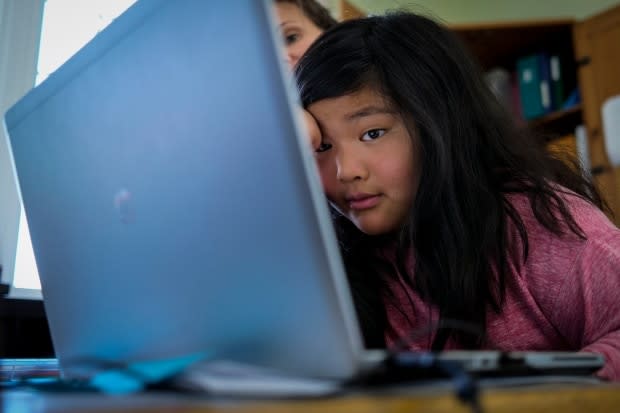What fully-online learning will look like for Ontario students who stay home this fall
Parents of the two million students in Ontario schools face a choice this month: whether to opt for fully-online learning for September as a way to reduce their children's risk of exposure to COVID-19 in the classroom.
The Ministry of Education is requiring all school boards to provide the option of full-time remote learning as an alternative to coming to school when the doors reopen next month.
The province's reopening plan has elementary students in class five days a week with no shrinking of their normal class sizes, while high school students in large urban centres have a mix of online learning and face-to-face teaching in classes of no more than 15.
School boards across Ontario will survey parents in the coming weeks to find out how many students won't be attending in-class instruction and instead will learn online.
Few parents would choose the fully-online option if schools were better set up to prevent the spread of COVID-19, says Annie Kidder, executive director of the People For Education advocacy group.

"I think that we're going to see divisions along socioeconomic lines," Kidder said in an interview with CBC News. "That divide will be incredibly problematic for all kids."
Kidder predicts wealthier and more empowered families are the most likely to opt for the online-only model.
"Online learning, especially for younger kids, really does involve parents and not all parents have the same capacity to support their kids in doing that," she said.
After the sudden closure of schools when the pandemic hit in the spring, teachers around Ontario were largely left to themselves to figure out how to deliver their lessons online. The results were, at best, mixed.
"The biggest caution in this is for students who were already at a disadvantage," said Kidder.
"For some kids who were already struggling, online learning was difficult if not impossible. We have to make sure that we're not just writing those kids off."
Premier Doug Ford says the online option gives parents a choice if they fear the risks of sending their children to class.
"They don't have to put their kids in school. They can keep them home and do online learning," Ford said during his daily news briefing Tuesday.

Asked Wednesday how his government will ensure the quality of online instruction this fall, Ford didn't answer the question directly, but expressed a preference for in-class learning. "It all depends on the teacher," said Ford. "When you have a phenomenal teacher, you just seem to do better in their class."
The Ministry of Education says it will soon outline standard requirements for the distance learning model, including how much teaching must be "synchronous," with the teacher providing live remote instruction to students.
Various school boards have begun revealing some specifics about their fully remote option, including how online instruction would differ from the youngest to oldest students, and the policies on switching to and from the at-home model.
"We had some real success stories from the first go round with remote learning," said Kathy Witherow, associate director of education at the Toronto District School Board. However, full-time online learning this fall will look different from what it was in the spring, Witherow told a meeting of trustees this week.
For TDSB elementary students in the fully remote-learning option, one teacher would be assigned to each grouping or cohort, Witherow said.
The teacher would use a mix of teaching the entire group at the same time and splitting time among small groups. As well, students would spend time on individual and group work without the teacher.
Board educational staff who specialize in online learning will work with the classroom teachers who take on the fully-remote cohorts to help them develop their course content.

TDSB high school students choosing the fully online option would do two courses at a time in each of the four "quadmesters" dividing the school year, the same structure as for students coming to in-class instruction, said Witherow.
The fully-online secondary students would spend the morning on one course and the afternoon on the other, with at least 90 minutes daily in each course connected online with their teacher.
The province's second-largest school board, the Peel District School Board, is asking parents to register for the online-only model by Aug. 14.
"Students who choose this option will only receive instruction at home through distance learning, but families will be able to choose in-person at another point in the school year," said the Peel board in a recent posting on its website.
"This instruction will be delivered by Peel board educators, but not necessarily by staff assigned to a particular school or class."
The Ottawa Catholic School Board is asking parents of elementary students who choose the fully-online option to commit to sticking with it for three months and for high school students to commit until January, for the entire first semester.
"Your children will be assigned to a class grouping as they would in a conventional school year," the Ottawa Catholic board says in a memo to parents.
"Assigning students will allow class groupings to be maintained despite the form of delivery that is in place."


